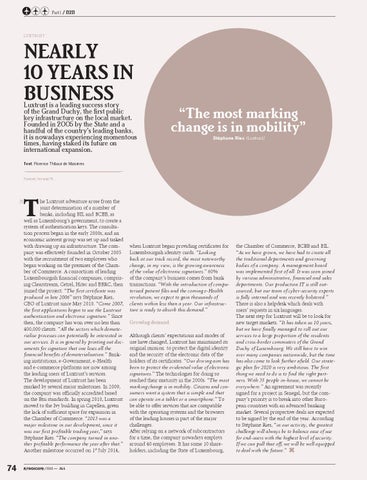Part 1 // B2B
LUXTRUST
NEARLY 10 YEARS IN BUSINESS
Luxtrust is a leading success story of the Grand Duchy, the first public key infrastructure on the local market. Founded in 2005 by the State and a handful of the country’s leading banks, it is nowadays experiencing momentous times, having staked its future on international expansion.
“The most marking change is in mobility” Stéphane Ries (Luxtrust)
Text: Florence Thibaut de Maisières
Français, lire page 72...
EN
74
T
he Luxtrust adventure arose from the joint determination of a number of banks, including BIL and BCEE, as well as Luxembourg’s government, to create a system of authentication keys. The consultation process began in the early 2000s, and an economic interest group was set up and tasked with drawing up an infrastructure. The company was effectively founded in October 2005 with the recruitment of two employees who began working on the premises of the Chamber of Commerce. A consortium of leading Luxembourgish financial companies, comprising Clearstream, Cetrel, Hitec and EBRC, then joined the project. “The first certificate was produced in late 2006” says Stéphane Ries, CEO of Luxtrust since May 2010. “Come 2007, the first applications began to use the Luxtrust authentication and electronic signature.” Since then, the company has won over no less than 400,000 clients. “All the sectors which dematerialise processes can potentially be interested in our services. It is in general by printing out documents for signature that one loses all the financial benefits of dematerialisation.” Banking institutions, e-Government, e-Health and e-commerce platforms are now among the leading users of Luxtrust’s services. The development of Luxtrust has been marked by several major milestones. In 2009, the company was officially accredited based on the Etsi standards. In spring 2010, Luxtrust moved to the Ivy building in Capellen, given the lack of sufficient space for expansion in the Chamber of Commerce. “2013 was a major milestone in our development, since it was our first profitable trading year,” says Stéphane Ries. “The company turned in another profitable performance the year after that.” Another milestone occurred on 1st July 2014,
when Luxtrust began providing certificates for Luxembourgish identity cards. “Looking back at our track record, the most noteworthy change, in my view, is the growing awareness of the value of electronic signatures.” 60% of the company’s business comes from bank transactions. “With the introduction of computerised patient files and the coming e-Health revolution, we expect to gain thousands of clients within less than a year. Our infrastructure is ready to absorb this demand.”
Growing demand Although clients’ expectations and modes of use have changed, Luxtrust has maintained its original mission: to protect the digital identity and the security of the electronic data of the holders of its certificates. “Our driving aim has been to protect the evidential value of electronic signatures.” The technologies for doing so reached their maturity in the 2000s. “The most marking change is in mobility. Citizens and consumers want a system that is simple and that can operate on a tablet or a smartphone.” To be able to offer services that are compatible with the operating systems and the browsers of the leading houses is part of the major challenges. After relying on a network of subcontractors for a time, the company nowadays employs around 40 employees. It has some 10 shareholders, including the State of Luxembourg,
the Chamber of Commerce, BCEE and BIL. “As we have grown, we have had to create all the traditional departments and governing bodies of a company. A management board was implemented first of all. It was soon joined by various administrative, financial and sales departments. Our production IT is still outsourced, but our team of cyber-security experts is fully internal and was recently bolstered.” There is also a helpdesk which deals with users’ requests in six languages. The next step for Luxtrust will be to look for new target markets. “It has taken us 10 years, but we have finally managed to roll out our services to a large proportion of the residents and cross-border commuters of the Grand Duchy of Luxembourg. We still have to win over many companies nationwide, but the time has also come to look further afield. Our strategic plan for 2020 is very ambitious. The first thing we need to do is to find the right partners. With 35 people in-house, we cannot be everywhere.” An agreement was recently signed for a project in Senegal, but the company’s priority is to break into other European countries with an advanced banking market. Several prospective deals are expected to be signed by the end of the year. According to Stéphane Ries, “in our activity, the greatest challenge will always be to balance ease of use for end-users with the highest level of security. If we can pull that off, we will be well equipped to deal with the future.” .
FLYDOSCOPE // 2015 — \4
072-074_B2B6.indd 74
09/09/15 12:06
